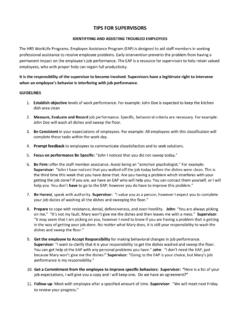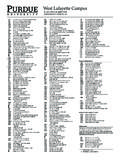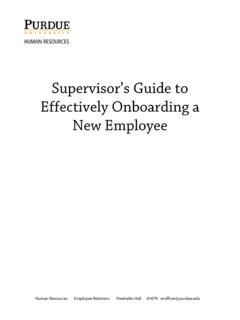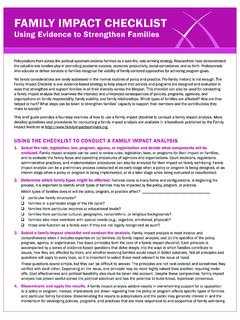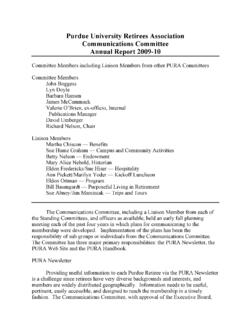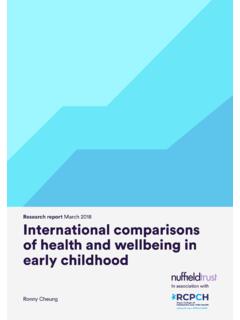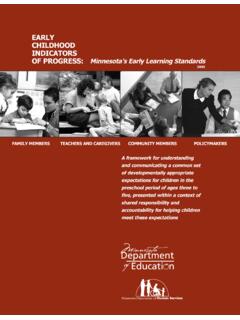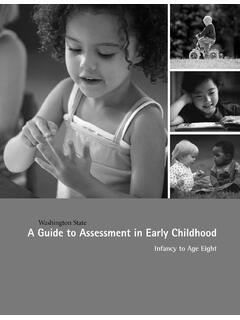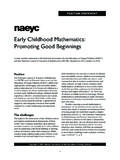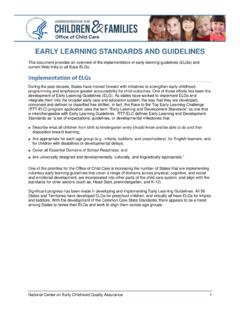Transcription of Early Childhood Education (pdf) - Purdue University
1 Early Childhood Education by Douglas R. Powell Research-based blueprints for federal, state and local Early Childhood policies and programs have been issued in unprecedented numbers in the past decade, providing a well-developed agenda for promoting competence in young children as we enter the 21st century. Never before has there been a clearer set of informed recommendations for strengthening Early Childhood development than is now available to policymakers, professionals and parents, as illustrated in Table 1. Table 1. Selected National Policy Reports on Early Childhood Ready to Learn: A Mandate for the Nation, Carnegie Foundation for the Advancement of Teaching (Boyer 1991) Never before has there been a clearer set of informed recommendations for strengthening Early Childhood development than is now available to policymakers, professionals and parents.
2 Caring Communities: Supporting Young Children and Families, National Task Force on School Readiness, National Association of State Boards of Education (1991) Starting Points: Meeting the Needs of Our Youngest Children, Carnegie Task Force on Meeting the Needs of Young Children (1994) Years of Promise: A Comprehensive Learning Strategy for America's Children, Carnegie Task Force on Learning in the Primary Grades (1996) Not by Chance: Creating an Early Care and Education System for America's Children, Quality 2000 Initiative (Kagan & Cohen 1997) Ready Schools, National Education Goals Panel (Shore 1998) Learning to Read and Write: Developmentally Appropriate Practices for Young Children, International Reading Association and the National Association for the Education of Young Children (1998) Preventing Reading Difficulties in Young Children, Committee on the Prevention of Reading Difficulties in Young Children, Commission of Behavioral and Social Sciences and Education , National Research Council (Snow et al.)
3 1998) Eager to Learn: Educating Our Preschoolers, Committee on Early Childhood Pedagogy, National Research Council (Bowman, Donovan, & Burns, 2000) From Neurons to Neighborhoods, Committee on Integrating the Science of Early Childhood Development, National Research Council and Institute of Medicine (Shonkoff & Phillips, 2000) Indiana Family Impact Seminars - January 2001 29 30 Indiana Family Impact Seminars January 2001 The recommendations vary in emphasis but the commonalities are striking, reflecting a growing consensus that all children are entitled to environments that are developmentally stimulating, nurturing and challenging.
4 The first goal of the National Education Goals adopted by the 50 governors and President George H. Bush in 1989 makes the strongest national statement about this concern. Subsequently incorporated into the "Goals 2000: Educate America Act" that was signed into law by President Bill Clinton in 1994, the goal states that "by the year 2000, all children in America will start school ready to learn." Toward this end it calls for: All children to have access to high-quality and developmentally appropriate preschool programs to prepare them for school; Every parent in the United States to be a child's first teacher and to devote time daily helping the child to learn; and All children to receive the nutrition, physical activity experiences, and healthcare needed to arrive at school with healthy minds and bodies; and the mental alertness necessary for learning.
5 Why the Press to Improve Early Childhood Outcomes? A number of factors have stimulated this interest in the Early years and are driving current ideas about how to facilitate the development of young children into competent and productive adults. Indicators of Early Childhood Well-being Point to Problems The United States does not compare well with most other industrialized countries on many indicators of Childhood well-being. Included in these indicators are: infant mortality rate, percentage of low birthweight babies, proportion of babies immunized against Childhood diseases, and the rate of babies born to adolescent mothers.
6 Too many young children are living in poverty. About 20 percent of American children and youth live in families below the poverty level, with the greatest prevalence among younger children; one in four infants and toddlers live below the poverty line. While the percentage of children living in poverty has remained fairly steady since 1981, income disparities have grown significantly: The percentage of children in both high-income and extreme-poverty families has risen, while the percentage of children living in medium-income families has fallen (Federal Interagency Forum on Child and Family Statistics 1998).
7 The detrimental effects of poverty begin Early . Children living below the poverty line are more likely to experience poor general health and high levels of blood lead, housing problems, and hunger. They are less likely to be up to date on immunizations or to have a regular source of healthcare, to be enrolled in Early Childhood Education , or to have a parent working full time. Research consistently shows that persistent poverty has greater detrimental effects on IQ, school achievement and socioemotional functioning than short-term or transitory poverty. Children experiencing both types of poverty typically fare less well than those not experiencing socioeconomic disadvantage (McLoyd 1998).
8 Indiana Family Impact Seminars - January 2001 31 Early Childhood enrichment is lacking in many homes. Survey data on family practices that can enable the development of children's reading and writing skills point to a lack of literacy-rich environments in the homes of many children. A 1996 survey found that only 57 percent of children ages 3 to 5 were read aloud to every day (Federal Interagency Forum on Child and Family Statistics 1998). The Early Years Matter There is far more extensive development in the first year of life than had been previously demonstrated, pointing to the risk of serious developmental problems caused by adverse Early environments.
9 The Early years of life constitute a formative or critical period that shapes the course of development. An influential report on the Early years issued by the National Research Council and Institute of Medicine (Shonkoff & Phillips, 2000) concludes: "From birth to age 5, children rapidly develop foundational capabilities on which subsequent development builds. In addition to their remarkable linguistic and cognitive gains, they exhibit dramatic progress in their emotional, social, regulatory, and moral capacities. All of these critical dimensions of Early development are intertwined, and each requires focused attention.
10 " Research on brain functioning points to the lasting effects of the Early years. Sophisticated tools for brain scans allow researchers to examine the impact of environments on the structure and functioning of the developing brain (Nelson & Bloom 1997). There is far more extensive development in the first year of life than had been previously demonstrated, pointing to the risk of serious developmental problems caused by adverse Early environments. High-quality Early Childhood Programs Are Effective Many evaluations of Early Childhood programs have been conducted with disadvantaged populations. Among children from low-income families, significant gains in intellectual performance and socioemotional development have been measured at the end of only one year of intervention through model Early Childhood programs.

